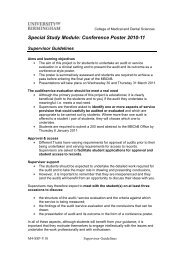Contents - College of Medical and Dental Sciences - University of ...
Contents - College of Medical and Dental Sciences - University of ...
Contents - College of Medical and Dental Sciences - University of ...
Create successful ePaper yourself
Turn your PDF publications into a flip-book with our unique Google optimized e-Paper software.
The 11 th International Workshop on KSHV & Related Agents, Birmingham, UK<br />
Latency Abstract 7<br />
MULTIPLE DOMAINS CONTRIBUTE TO THE ASSOCIATION OF LANA WITH HOST<br />
CHROMATIN COMPONENTS<br />
Ryo Nasu, Satoko Matsumura, Naoko Tanese <strong>and</strong> Angus Wilson<br />
Department <strong>of</strong> Microbiology & NYU Cancer Institute, New York <strong>University</strong> School <strong>of</strong><br />
Medicine, New York, NY 10016, USA<br />
Abstract<br />
The latency-associated nuclear antigen (LANA, LANA1, LNA1) encoded by ORF73 is<br />
expressed in all KSHV infected cells <strong>and</strong> performs a variety <strong>of</strong> functions associated with<br />
maintenance <strong>of</strong> the viral genome <strong>and</strong> proliferation <strong>of</strong> the infected host cell. As its name<br />
indicates, LANA accumulates in the nucleus where it is associated with host chromosomes<br />
throughout the cell cycle. Direct interactions with a number <strong>of</strong> chromatin components<br />
have been described but the functional significance <strong>of</strong> these interactions is not fully<br />
understood. We have focused on the association <strong>of</strong> LANA with methyl-CpG binding<br />
protein 2 (MeCP2) <strong>and</strong> core histones. Evidence will be presented showing that both the<br />
N- <strong>and</strong> C-terminal domains <strong>of</strong> LANA contribute to interaction with MeCP2 <strong>and</strong> this can<br />
direct LANA to regions <strong>of</strong> pericentric heterochromatin. Localization is dependent on the<br />
methyl-CpG binding (MBD) <strong>and</strong> adjacent trans-repression (TRD) domains <strong>of</strong> MeCP2. The<br />
chromatin binding motif (CBM) at the extreme N-terminus <strong>of</strong> LANA (residues 5-11)<br />
influences subcellular localization but is not strictly required for MeCP2 binding. Instead,<br />
the CBM recognizes the four histones that form the nucleosome core. In addition to<br />
interactions with histones H2A/H2B previously described by the Kaye <strong>and</strong> Luger<br />
laboratories, we will present evidence for additional interactions with histones H3 <strong>and</strong> H4.<br />
Sedimentation studies employing recombinant proteins show that the LANA CBM is<br />
capable <strong>of</strong> assembling isolated nucleosomes into compacted structures that may serve to<br />
regulate host <strong>and</strong> viral gene expression.<br />
Presenting author Email: wilsoa02@med.nyu.edu<br />
27















